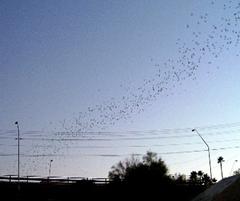|
Ultrasonic
recording is a superior alternative to bat detectors for collecting
acoustic data in the field. The reason is simple. An ultrasonic
recorder is capable of recording the full ultrasonic frequency range
over an entire event such that nothing is missed. The advantage of this
approach is dramatic when compared against the limitations of typical
bat detectors. First, the recording duration of an ultrasonic recorder
can be up to many hours or days, depending on disk size. Typical bat
detectors only have a limited snapshot duration, so there is no way to
guarantee that you will collect all the events of interest in the
field. Second, an ultrasonic recorder collects records at full
bandwidth which means that it accurately records the entire acoustic
environment without any alteration or degradation of any kind. Some
bat detectors only allow recording the translated audio output, which in
most cases alters the signal quality to the point that it not useful for
any further analysis (See ďDetectionĒ for a discussion of the
limitations of bat detector techniques).
To
demonstrate the capabilities of ultrasonic recording, I used an
AR125
receiver package to record a Mexican Free-Tail colony just after
sunset. I recorded about twenty minutes of data and captured the
vocalizations just prior to, during, and after the colony took flight.
Afterward, I post processed the recording using
SPECTíR along with an
inexpensive audio processing tool to produce the snippets below. I
picked these particular snippets because they illustrate the wide range
of vocalizations that free-tail bats employ and the advantage gained
using ultrasonic recording in the field.
|
 |
A Mexican Free-Tail bat colony taking flight at
sunset, Tucson Arizona. Recorded in September 2004 using a
AR125 ultrasonic receiver, SPECTíR software and a Dell notebook
computer. |
|
|
MP3 Downloads (click on microphone icon) |
 |
Preflight
This is a recording of Mexican free-tail bat social calls. It was taken
just prior to flight. The social calls are in the upper range of normal
hearing. |
 |
In flight : Heterodyne only
This is a recording of the bats as they are taking flight in one large
column. The vocalization frequency was around 30KHz. It was tuned down
to normal hearing range using only a heterodyning technique. |
 |
In flight : Time-Stretch plus heterodyne
This was generated from the same recording as above, but it employs
time-stretching (1:8) and heterodyning to improve the ultrasonic to
audio translation. Amazing difference, hear it for yourself! |
 |
Hunting : Heterodyne only
After taking flight, the bats break up into smaller groups to hunt for
insects. The vocalizations change to become longer duration
echo-location chirps. Sounds like something out of a Star-Wars
soundtrack! |
|
Vocalization Analysis
To explain
the benefits of ultrasonic recording, there is still one more topic to
cover, bat
vocalization analysis.
While the audio translation techniques above were useful in the past,
modern bat vocalization analysis is actually performed using
full-bandwidth recordings. Ultrasonic receivers are ideal for this! I
have included a few full bandwidth snapshot files for your enjoyment.
They are large files (approximately 0.5 Mbytes), recorded with the
standard WAV file format. The files are time expanded so you can play
them through a media player, but you will need software, like SPECTíR,
SCANíR,
or SonoBat (www.sonobat.com) to be
able to perform vocalization analysis. |
|
Time Expanded Downloads (Click on icon) |
 |
Long-legged Myotis (488 KBytes)
This is a recording of a long-legged Myotis as it was being released. |
 |
Hoary bat (488 KBytes)
This is a recording of a Hoary bat. This recording was also made as the
bat was being released. Notice how this bat switches the vocalization
power into the second harmonic, mid call. Interesting... |